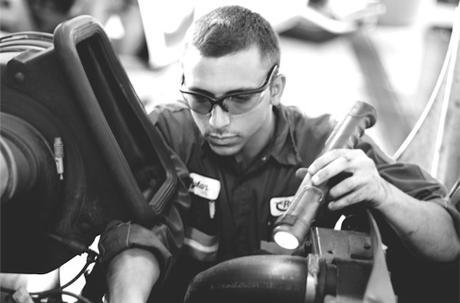 This blog is the first in a five-part series examining the maintenance landscape facing today’s fleet operators. Future posts will focus on the technician shortage, the emergence of automatic manual transmissions, the hidden maintenance costs in your fleet, and how big data is having a dramatic impact on how you manage maintenance.
This blog is the first in a five-part series examining the maintenance landscape facing today’s fleet operators. Future posts will focus on the technician shortage, the emergence of automatic manual transmissions, the hidden maintenance costs in your fleet, and how big data is having a dramatic impact on how you manage maintenance.
It’s tough being a fleet operator in an era of heightened fuel emission standards.
Even as the industry still navigates the impacts of the 2014 engine technology standards and related service and maintenance regimen, the Environmental Protection Agency (EPA) has introduced “Phase II” of proposed regulations that will seek to reduce by one billion tons the carbon emissions and greenhouse gases from vehicles built from 2018 to 2027. The EPA estimates the regulations will save about 1.8 billion barrels of oil and $170 billion in fuel costs.
For their part, manufacturers are expected to make available multiple technologies that will deliver more energy-efficient vehicles. They likely will ramp up investments in new cab designs, axle ratios, aerodynamic enhancements, and will now look beyond the power unit to look for additional efficiencies through new trailer designs and technologies. The costs of adopting the proposed optimal fuel-efficient technologies could reach $10,000 to $12,000 per vehicle for large trucks, the EPA estimates, and somewhat less for smaller trucks.
How can fleet operators and manufacturers, and the transportation industry at large, help meet the challenge? It’s time to become a vital partner in the quest to boost fuel and freight efficiency. Shippers and their 3PL partners can employ practices and policies that will improve overall efficiency , which could lower transportation costs and boost shipper returns in kind.
Four strategies fleet operators should be considering now, even ahead of the new proposed regulations, include:
- Pursuit of practices for total freight efficiency. This could reduce the number of vehicles on the road and improve overall performance and bottom-line returns, while also limiting emissions.
- Investigation and use of fuel types that generate the best CO2 g/ton mile. As fuel options become more sophisticated, fleet operators can improve their performance and compliance through diversification.
- Exploration of how to work through the impacts of trailer weight and length laws that currently limit productivity, while still focusing on improving safety.
- Selection of the right fuel, engine, powertrain, and trailer configuration to best meet their needs, while still complying with regulatory mandates. This complex matrix will require collaboration from across the organization.
In summary, regulatory standards are expected to further challenge fleet operators and manufacturers. To stay ahead of the curve and comply with mandatory emission reductions, pursue a policy of proactive adoption of the available efficiency technologies and a strategy that could ease the impact of regulatory changes – and improve bottom line results.
Look for second installment of this series coming soon.
Written by Scott Perry
Scott Perry is Vice President, Supply Management & Global Fuel Products with Ryder System Inc. He is responsible for defining and managing vehicle and parts procurement strategy, corporate real estate and strategic infrastructure, , new vehicle technologies, as well as overseeing Ryder’s diesel products portfolio and advanced fuel program.

